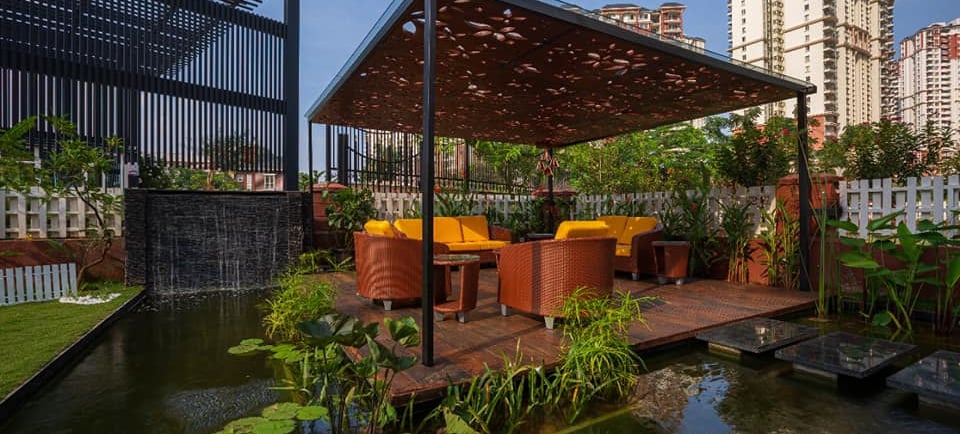Understanding and Preventing Water Leakage Problems in Pergolas
PERGOLA & GAZEBO


Water Leakage in Pergolas!
Water leakage in pergolas represents a significant concern for homeowners and property managers alike. As outdoor structures designed to enhance the aesthetic appeal and functionality of gardens and patios, pergolas are often subjected to various environmental conditions that can lead to moisture-related issues. Early identification of water leakage problems is crucial to prevent extensive damage that can compromise the structural integrity of the pergola and the surrounding landscape.
Several factors contribute to water leakage in pergolas. One of the primary reasons is poor drainage. If a pergola is built without proper drainage systems, rainwater can accumulate on the roof or the surrounding areas, leading to leaks. Inadequate sealing is another common cause. Gaps between boards, improperly installed roofing materials, or the absence of waterproofing solutions can allow water to penetrate the structure, resulting in damage over time.
Environmental conditions can also play a significant role in the occurrence of water leakage. For instance, regions experiencing heavy rainfall or persistent humidity levels are more susceptible to water-related issues. The use of low-quality materials in construction may further exacerbate these problems, as they might not withstand the effects of moisture in the long term. Regular maintenance and inspections are vital for identifying vulnerabilities that could lead to water leakage.
Overall, understanding and addressing the common causes of water leakage in pergolas can help protect these structures and extend their lifespan. By taking proactive measures, such as ensuring proper drainage, using high-quality sealing materials, and conducting regular inspections, homeowners can mitigate the risks associated with water damage and preserve their outdoor spaces. Identifying these issues early on is essential for maintaining both the aesthetic value and functionality of the pergola.
Common Causes of Water Leakage in Pergolas
Water leakage in pergolas can result from various factors, which may significantly compromise their structural integrity and usability. One of the primary causes is faulty installation practices. When a pergola is not constructed according to recommended guidelines, it can create gaps or misalignments that allow water to seep through. It is crucial for builders to ensure that all components fit snugly together and that the design allows for adequate drainage.
Another key element contributing to water leakage is the age and wear of materials. Over time, the components of a pergola—be it wooden, metal, or fabric—are subject to deterioration due to exposure to environmental elements such as rain, sunlight, and wind. For example, wooden pergolas may develop cracks, splinters, or rot, making them more susceptible to leaks. Similarly, fabric can become frayed or torn, allowing water to penetrate.
Improperly positioned roof slopes also play a vital role in the prevention of water leakage. The roof of a pergola should be designed with a slope that facilitates water runoff. If the slope is inadequate, water can accumulate on the surface, leading to leaks. Regular maintenance checks can help identify slope issues before they manifest as significant problems.
Moreover, the impact of weather elements cannot be overlooked. Severe weather conditions, such as heavy rainfall or hailstorms, can exacerbate existing vulnerabilities in pergola materials. It is essential for homeowners to choose materials that offer good resistance to weather-related wear and to invest in regular upkeep to extend the lifespan of their structures.
Understanding these common causes can help pergola owners take proactive measures to prevent water leakage, ensuring their outdoor spaces remain enjoyable and functional.
Symptoms and Signs of Water Leakage
Recognizing the symptoms of water leakage in pergolas is paramount for homeowners aiming to maintain the integrity of their outdoor structures. One of the primary indicators of water leakage is the presence of water stains on the decking or the underside of the pergola roof. These stains may appear as dark patches or discoloration on the wood or metal, signaling that water is penetrating the materials. Over time, if left unaddressed, these stains can contribute to more severe issues, such as wood rot or rust in metal components.
Another critical sign of water leakage is the growth of mold or mildew around the pergola. Fungi thrive in damp environments, and their presence often indicates that moisture is accumulating in areas where it should not be. Mold not only compromises the aesthetic appeal of your pergola but also poses potential health risks to occupants. Regular examinations of the affected areas can assist in promptly identifying and addressing moisture-related issues.
Structural deterioration is yet another serious symptom of water leakage. Homeowners should be vigilant for any signs of sagging or warped beams, as these can indicate that the structural integrity of the pergola has been compromised due to prolonged exposure to moisture. Cracked wood or rusted metal fasteners are also red flags that should not be ignored.
Routine inspections and maintenance play a critical role in identifying these symptoms early. Homeowners are encouraged to periodically check for water stains, mold growth, and signs of deterioration, especially after heavy rainfall or storms. Proactively addressing these symptoms can prevent minor issues from escalating into significant problems, ensuring that the pergola remains a valuable and safe addition to the home.
Prevention and Solutions for Water Leakage Issues
Preventing water leakage in pergolas is crucial for maintaining their structural integrity and ensuring a comfortable outdoor space. One of the most effective strategies to prevent leakage is proper installation. It is essential to ensure that the pergola's framework is constructed correctly, with appropriate slopes to direct rainwater away from the structure. Materials should be selected with care, prioritizing those that are naturally resistant to moisture, such as treated wood, aluminum, or vinyl. These options are less prone to warping and deterioration over time compared to untreated materials.
Additionally, the importance of regular maintenance cannot be overstated. Homeowners should schedule periodic inspections of their pergolas, checking for signs of wear, damage, or water stains, which can indicate potential leakage issues. Cleaning gutters and downspouts regularly can further reduce the risk of water accumulating around the pergola, which could lead to seepage. Applying waterproof sealants to joints and seams is another effective method to enhance the water resistance of the pergola. These sealants help to fill gaps that could allow moisture to enter, thus preserving the longevity of the structure.
When designing a pergola, incorporating appropriate drainage systems can significantly mitigate the risk of leakage. Options such as integrated gutter systems or strategically placed downspouts will facilitate the effective diversion of water away from the pergola. Additionally, designing the pergola with overhangs can provide extra protection against rain, ensuring that the areas most vulnerable to leakage are adequately covered. Ultimately, a holistic approach that combines the correct materials, rigorous maintenance routines, and thoughtful design considerations will lead to a well-protected pergola that withstands the test of time and weather elements.


